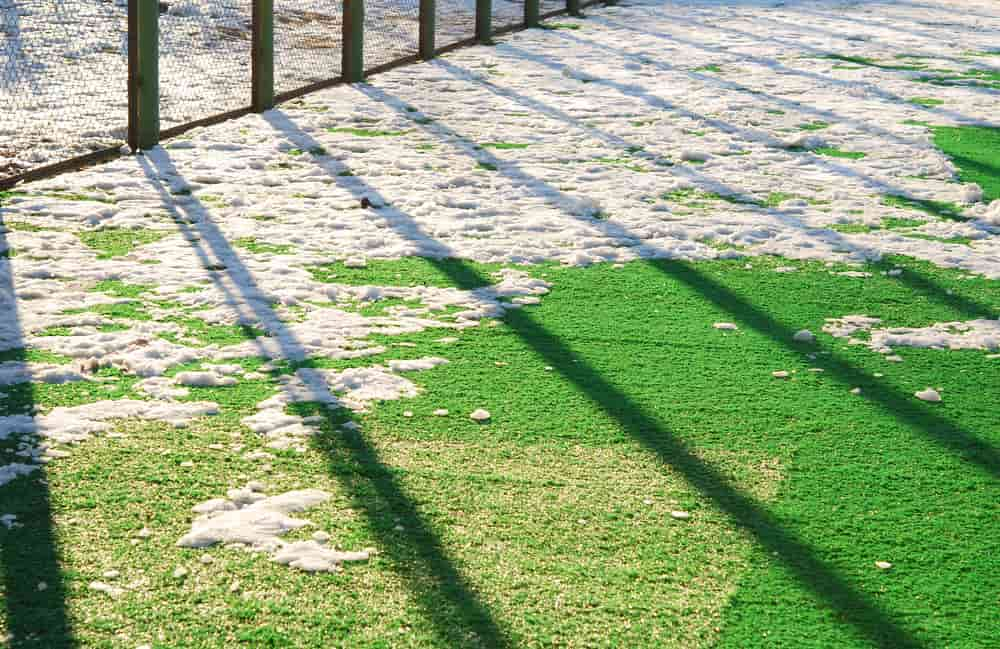As the temperatures are plummeting throughout the country, a common question our customer service team receive this time of year is whether frost or snow can damage artificial grass. The good news is that high-quality artificial grass is designed...
As the temperatures are plummeting throughout the country, a common question our customer service team receive this time of year is whether frost or snow can damage artificial grass. The good news is that high-quality artificial grass is designed to withstand various weather conditions, including cold and snowy environments. However, certain precautions are advisable to maintain its longevity and appearance:
Gentle De-Icing: If you anticipate ice formation, avoid harsh chemicals for de-icing. Instead, use a pet-friendly, non-corrosive de-icing product. Excessive salt or chemical de-icers can damage the turf fibers and affect the soil pH below.
Pre-Winter Inspection: Before the onset of winter, inspect your artificial grass for any signs of wear or damage. Repairing minor issues beforehand can prevent them from worsening due to frost or heavy snowfall.
Snow Removal Plan: Develop a strategy for snow removal that minimizes damage. Use a plastic shovel or a leaf blower for light snow. For heavier snow, a soft, non-metallic brush can be effective. Avoid sharp tools that could cut or rip the turf.
Anti-Frost Covers: In regions with light frost, consider using a breathable fabric cover to protect the grass. This cover can prevent frost from settling directly on the turf, making it easier to manage on frosty mornings.
Drainage Check: Ensure the drainage system of your artificial grass is clear and functioning efficiently. Proper drainage prevents water accumulation and ice formation, which can be heavy and put strain on the turf.
Reduced Foot Traffic: During snowy or frosty conditions, try to minimize walking on the artificial grass. While it’s resilient, repeated foot traffic on frozen or snow-covered turf can lead to matting or fiber damage.

Artificial turf, made from synthetic materials, typically resists the effects of freezing temperatures. Unlike natural grass, it does not become dormant or risk damage from frost. When snow falls on artificial grass, it sits on the surface without penetrating the fibers. This resistance to moisture penetration ensures that the turf remains undamaged by frost.
Nevertheless, it’s crucial to handle snow removal carefully. Using sharp tools, like metal shovels, can harm the grass fibers. Opt for plastic snow shovels or brushes to gently clear the surface. This approach prevents potential abrasions or tears in the turf.
Heavy snowfall, while not directly harmful, can lead to issues if not managed properly. Prolonged snow cover might flatten the grass blades, affecting the turf’s aesthetic appeal. To avoid this, periodically brush off the snow, allowing the blades to retain their upright position.
Melting snow is another aspect to consider. The drainage system beneath the artificial grass plays a vital role here. It’s designed to allow water to pass through, preventing waterlogging and ice formation. Ensuring that the drainage system is unobstructed is crucial for the turf’s health during thawing periods.
In summary, artificial grass is resilient against frost and snow. However, proper maintenance during winter ensures that it remains in top condition. By using appropriate tools for snow removal and monitoring the drainage system, your artificial grass should weather the winter without any significant issues.
The post Can Artificial Grass Get Damaged by Frost or Snow in the winter? appeared first on Artificial Grass Direct Ltd.











